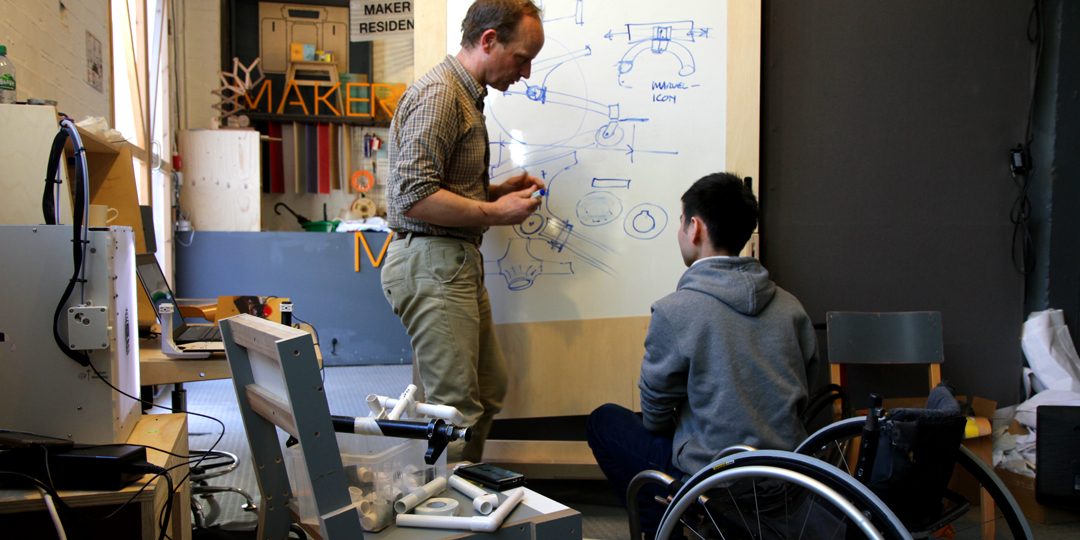 Dan Chambers from Draft wheelchairs came to visit Hello Shenzhen resident Kang Cheng at Machines Room to show him how wheelchairs are measured and made. Crammed into the Maker Library we went through all the parts of the wheelchair and learnt about the purpose of the different parts. It was amazing to see how well engineered custom built frame chairs are, the Disrupt Disability chair we have at Machines Room is made out of titanium tubing – each length of tubing has to be bespoke bent for the individual and the entire chair is made by hand.
Dan Chambers from Draft wheelchairs came to visit Hello Shenzhen resident Kang Cheng at Machines Room to show him how wheelchairs are measured and made. Crammed into the Maker Library we went through all the parts of the wheelchair and learnt about the purpose of the different parts. It was amazing to see how well engineered custom built frame chairs are, the Disrupt Disability chair we have at Machines Room is made out of titanium tubing – each length of tubing has to be bespoke bent for the individual and the entire chair is made by hand.
We learnt about how there are variables based on the individual’s body size, but also the extent of their disability. For example someone with less leg control might want higher tubing for their footrest to give more support. Sizing can change due to the personal preference of the wearer. The one we were testing has a seat positioned quite far behind the axel, making it ‘tippy’. This imbalance makes it easier to get up kerbs and small steps but it also means that you need to have more core control in order to tip and not fall out the back of the chair – for the unexperienced there is a real danger of cracking your head open, so we wear a helmet when testing!
Dan reviewed the hub design that Rachael and Kang have been working which is based on the idea of all the components of a wheelchair being interchangeable. He suggested we look at the Maverick chair which has a central hub and interchangeable casters. Dan talked through which parts of the wheelchair you might want to be interchangeable, and which parts you would only customise once.
The width and the seat only need to be customised once as these are set by your size. However with the footrest and front castor wheels there are multiple different possibilities, but in most chairs these are set at manufacture. You might have a long mono wheel to go fast, wider wheels for rough terrain, and a set of day wheels for normal use.
We asked whether any of his clients had requested interchangeability in their chairs – he has some clients who purchase 2 sets of wheels, a day set and a smartset that is kept clean for meetings and special occasions. Most active users he said own multiple chairs such as an ‘off road’ chair or his speciality ski chairs.
After a good 3 hour whiteboard session we honed the hub design. Dan liked Kang’s design for a push button mechanism for changing parts but rather than being a sphere with 6 holes the new design turned into a curved tetrahedron with one hole for the axle and a foot at the top a bit like a bicycle seat post. This would accommodate a seat (moulded or 3d printed) that could be adjustable. The one hole at the front would be for the footrest and castor fork unit. We also had Rongsheng Zhang with us who is a filament expert and we learnt about filament strength and different filaments such as nylon and metal powder. Shifting his thinking from metal tubing towards 3d printing Dan suggested some changes; rather than the axel going through the centre of the sphere, it should go at the bottom of the shape as that would be stronger. We estimated that you could 3d print at 30% strength of tubing, therefore need to increase sizes of 3d printed elements by 30% to compensate.
This new simplified part will be pretty standardised apart from the length which could be parametrically changed based on the user’s body shape. Dan has kindly offered to will provide an axle for testing and Kang will update his design based on Dan’s input.